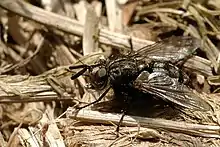| Triarthria setipennis | |
|---|---|
 | |
| Scientific classification | |
| Domain: | Eukaryota |
| Kingdom: | Animalia |
| Phylum: | Arthropoda |
| Class: | Insecta |
| Order: | Diptera |
| Family: | Tachinidae |
| Subfamily: | Tachininae |
| Tribe: | Bigonichetini |
| Genus: | Triarthria |
| Species: | T. setipennis |
| Binomial name | |
| Triarthria setipennis | |
| Synonyms | |
| |
Triarthria setipennis is a species of tachinid fly which parasitizes other insects, including earwigs.[9][10][11][12][13][14][15]
Distribution
Albania, Andorra, Belarus, Austria, Belgium, Bulgaria, Czech Republic, Denmark, Finland, France, Germany, Greece, Hungary, Italy, Lithuania, Norway, Poland, Romania, Russia, Slovakia, Spain, Sweden, Switzerland, Netherlands, Ukraine, United Kingdom.[11][12]
It has been introduced from Europe in the 1920s to control Forficula auricularia (European earwig) and it is established in British Columbia, Washington, Oregon, California, Idaho, Nevada, Utah, Newfoundland, New Hampshire, Massachusetts.[15]
References
- 1 2 Fallen, C.F. (1810). "Forsok att bestamma de i Sverige funne flugarter, som kunna foras till slagtet Tachina". K. Vetensk. Acad. Nya Handl. 31 (2): 253–287.
- ↑ Meigen, J. W. (1824). "Systematische Beschreibung der bekannten europaischen zweiflugeligen Insekten". Vierter Theil. Schulz-Wundermann, Hamm.: xii + 428 pp. Retrieved 9 May 2020.
- ↑ Robineau-Desvoidy, J.B. (1830). "Essai sur les myodaires". Mémoires présentés par divers savans à l'Académie Royale des Sciences de l'Institut de France (Sciences Mathématiques et Physiques). 2 (2): 1–813. Retrieved 7 January 2022.
- ↑ Meigen, Johann Wilhelm (1838). Systematische Beschreibung der bekannten europäischen zweiflügeligen Insekten. Vol. 7. Hamm. pp. xii + 1–434. Retrieved 28 June 2021.
- ↑ Rondani, C. (1845). "Descrizione didue generi nuovi insetti ditteri. Memoria duodecima per servire alla ditterologia italiana". Nuovi Ann. Sci. Nat. Bologna. 3 (2): 25–36, pl. 1.
- ↑ Macquart, P.J.M. (1848). "Nouvelles observations sur les insectes diptères d'Europe de la tribu des tachinaires (suite)". Annales de la Société Entomologique de France. 3 (2): 85–138, pls.3-6. Retrieved 27 June 2023.
- ↑ Newport, G. (1853). "Notes on the Dipterous parasites which attack the common earwing and the Emperor Moth". Proceedings of the Linnean Society of London. 2: 247–249.
- ↑ Robineau-Desvoidy, J.B. (1863). Histoire naturelle des diptères des environs de Paris. Tome premiere. Paris: Masson et Fils. pp. xii + 1143.
- ↑ Dimick, R.E. and Mote, D.C. (1934) Progress report regarding the introduction in Oregon of Digonocheata setipennis, a tachinid parasite of the European earwig. Journal of Economic Entomology 27, 863-865.
- ↑ Clausen, C.P. (1978) Dermaptera -- Forficulidae -- European Earwig. In: Clausen, C.P. (ed.) Introduced Parasites and Predators of Arthropod Pests and Weeds: A World Review, Handbook No. 480, United States Department of Agriculture, Washington, DC, pp. 15-18.
- 1 2 "Fauna Europaea version 2.4". European Commission. 26 September 2012. Retrieved 26 September 2012.
- 1 2 Chandler, Peter J. (1998). Checklists of Insects of the British Isles (New Series) Part 1: Diptera. Handbooks for the Identification of British Insects. Vol. 12. London: Royal Entomological Society of London. pp. 1–234. ISBN 0-901546-82-8.
- ↑ Belshaw, Robert (1993). "Tachinid Flies Diptera Tachinidae". Royal Entomological Society Handbooks. Royal Entomological Society of London. 10 (4ai): 170.
- ↑ van Emden, F.I. (1954). "Ditera Cyclorrhapha Calyptrata (I) Section (a) Tachinidae & Calliphoridae". Royal Entomological Society Handbooks. Royal Entomological Society of London. 10 (4a): 133.
- 1 2 O’Hara, James E.; Henderson, Shannon J.; Wood, D. Monty (5 March 2020). "Preliminary Checklist of the Tachinidae (Diptera) of the World" (PDF). Tachinidae Resources. Retrieved 14 June 2023.
This article is issued from Wikipedia. The text is licensed under Creative Commons - Attribution - Sharealike. Additional terms may apply for the media files.